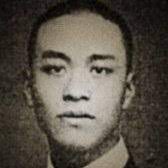Tuan Hsi-p'eng (1896-26 December 1948), a leader of the May Fourth demonstrations of 1919 and the first chairman of the Student Union of China. He taught history at Wuchang University in 1925 and at Kwangtung University in 1926. In 1932-37 he was vice minister of education, and in 1938 he became chairman of the education committee of the Kuomintang Central Training Corps.
Born into a scholarly family in Yunghsin, Kiangsi, Tuan Hsi-p'eng received his early education in the Chinese classics at home. He then enrolled at a normal school near Yunghsin, where he learned English. After graduation in 1916, he received a scholarship which enabled him to go to Peking and enroll at the law school of Peking University. Thus, he was a student at Peking University during its golden era under the chancellorship of Ts'ai Yuan-p'ei (q.v.)
Secret negotiations between the government of Tuan Ch'i-jui (q.v.) at Peking and the Japanese gave rise to student unrest in 1917-18. The floating of the so-called Nishihara loans (see Ts'ao Ju-lin) and the signing in May 1918 of the Sino-Japanese Military Mutual Assistance Conventions led to massive student demonstrations at Peking on 21 May 1918. Tuan Hsi-p'eng was among the 13 student representatives who met with Feng Kuo-chang (q.v.) that day in an attempt to learn the contents of the Sino- Japanese agreements and to press for the annulment of these and other agreements. Although the students failed to achieve their aims, the 1918 demonstrations were not insignificant. They served to unite the students and prepare the way for such significant joint actions as the May Fourth Incident of 1919 (for details, see Lo Chia-lun).
Tuan Hsi-p'eng helped organize the demonstrations of 4 May 1919, as a result of which 32 students were arrested. On 5 May, he presided at a meeting of some 3,000 students. The students called for the release of the 32 who had been arrested and resolved that they would boycott all classes until this demand was met. They also passed resolutions asking for the punishment of pro-Japanese officials and the restoration to China of Tsingtao.
To promote the patriotic May Fourth Movement, they established the Student Union of Peking, with Tuan as one of its chief representatives. Because their demands were refused by the government, Tuan and his colleagues went to Shanghai to organize a nation-wide student union. The Chung-hua min-kuo hsueh-shenglien-ho-hui (Student Union of the Republic of China) was established on 16 June at a meeting, held in the Ta Tung Hotel in Shanghai, which was attended by more than 30 student representatives and some 200 guests. Two days later, Tuan Hsi-p'eng was elected to a one-year term as chairman of this organization. As one of the best organized bodies of its day, the Student Union of China was a highly effective pressure group. It helped secure the release of the arrested students and the dismissal of several pro-Japanese officials.
After graduation from Peking University, Tuan Hsi-p'eng went abroad. In 1920-24 he studied successively at Columbia University, the University of London, Berlin University, and the University of Paris. Upon his return to China in the autumn of 1925, he joined the faculty of Wuchang University as a professor of history. The following year, he went to Canton, where he was appointed chairman of the history department at Kwangtung University.
In 1926 Ch'en Kuo-fu (q.v.) brought Tuan Hsi-p'eng into the organization department of the Kuomintang as part of his attempt to limit Communist influence in that body. Ch'en sent Tuan to Kiangsi in November to oversee party activities in that province. Tuan soon discovered that the provincial Kuomintang organization was dominated by such Communists as Fang Chih-min (q.v.). To counter Communist influence, Tuan organized the A. B. (anti- Bolshevik) Corps. His efforts were hindered by the establishment of the left-wing Kuomintang regime at Wuhan, for it supported the policy of collaboration with the Communists. On 1 April 1927 the Kiangsi provincial government and party organs were ordered reorganized, and anti-Communist officials were dismissed. A number of these anti-Communists were arrested the following day. On 4 April, Tuan fled Kiangsi in disguise. He went to Shanghai.
Subsequently, he played an important role in the purge of the Communists from the Kuomintang. Tuan became chief of the office of party guidance at Chiang Kai-shek's field headquarters at Nanchang in 1930 and a member of the Huai River Conservation Commission. In June 1932, having become vice minister of education, he was appointed acting president of National Central University in Nanking. Because of student opposition, the university had lacked a president for some time. When Tuan tried to assume office, the students assaulted him. The Executive Yuan then ordered the temporary dissolution of the University. Tuan continued to serve as vice minister of education until the end of 1937.
In February 1938 Tuan Hsi-p'eng became a member of the Central Executive Committee of the Kuomintang and chairman of the education committee of the Central Training Corps, the leading training center for Kuomintang cadres. Throughout the Sino-Japanese war, he devoted his attention to the activities of the Central Training Corps. He died of lung cancer on 26 December 1948 at Shanghai. Newspapers in Shanghai and Hong Kong eulogized Tuan as a righteous statesman who never lost his revolutionary spirit.

段锡朋
字:书诒
段锡朋(1896—1948.12.26),1919年五四游行时的领导人之一,中国学生联合会第一任主席。1925年、1926年先后在武昌大学、广东大学教历史。1932—37年任教育部次长,1938年任国民党中央训练团教育委员会主席。
段锡朋生在江西永新的一个读书人家里,幼年在家读中国古书,后进永新附近的师范学校学英语。1916年毕业后由官费去北京进北京大学政法科。他是蔡元培当校长的北京大学黄金时代的一个学生。
段祺瑞政府和日本的秘密条约引起1917—18年学生的骚动。西原借款和1918年5月签订的中日军事互助协定引起了1918年5月21日北京学生的大规模示威游行。段锡朋等十三名学生代表当天会见冯国璋,要求获知中日条约内容
并废除这些条约。他们的目的虽未达到,但1918年的示威游行并不是毫无意义的。他们促进了学生的联合并为1919年五四事件中的联合行动作了准备。
段锡朋参与组织了1919年的五四游行,游行结果是三十二名学生被捕。5月5日,他主持了大约三千人的学生集会,要求释放三十二名被捕学生,并决定为此举行总罢课直至学生被释。他们又通过决议要求归还青岛,惩处亲日官
吏。他们组织了北京学生联合会推进五四爱国运动,段是主要代表之一。上述要求被政府拒绝,段锡朋等人去上海组织全国学联,6月16日,“中华民国学生联合会”在上海大同旅社召开的一次会议上宣告成立,出席学生代表三十
人,来宾二百多人。两天后,选段为主席,任期一年。全国学联作为当时组织得最好的团体之一,成了一个极有效能的施加压力的社团,它促使被捕学生获释并免除了几个亲日官吏。
段锡朋在北京大学毕业后出国留学。1920—24年,先后进哥伦比亚大学,伦敦大学,柏林大学,巴黎大学学习。1925年秋,段回国在武昌大学当历史教授,翌年去广州,任广东大学历史系主任。
1926年,陈果夫把段锡朋带进国民党组织部,以限制共产党在国民党内的影响。11日,陈派段去江西视察党务。段发现该省国民党已由共产党人方志敏等人所控制,乃组织A.B.(反布尔什维克)团以资抗衡。他的活动为武汉主
张联共的国民党左派政府所阻。1927年4月1日,江西党政机构奉命改组,开除反共官员,次日,逮捕了一些反共成员,4月4日,段化装逃走到上海,嗣后,在国民党的清共活动中起了重要作用。
1930年,段任蒋介石南昌行营党务指导处长,导淮委员会委员。1932年6月,任教育部次长,南京国立中央大学代理校长。由于学生的反对,该校校长已缺任一段时间,段就任时,学生群起殴辱,行政院遂下令暂行解散该校。段继
任教育部次长至1937年。
1938年2月,段任国民党中央执行委员,中央训练团教育委员会主席,中训团是国民党主要的干部训练中心。中日战争期间,他一直从事中央训练团的工作。1948年12月26日因肺癌死在上海。上海和香港的一些报纸称赞他是始终
怀有革命精神的正直的政治家。